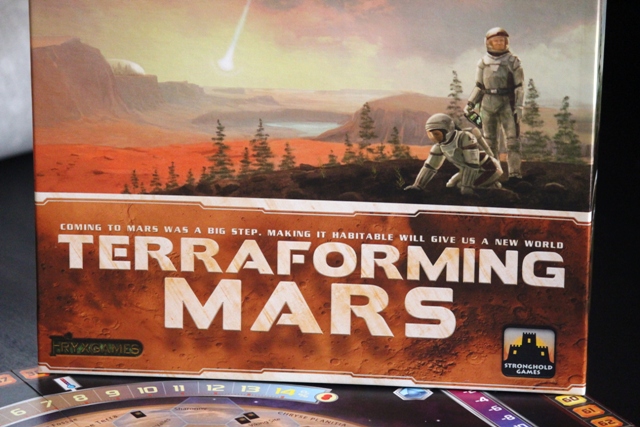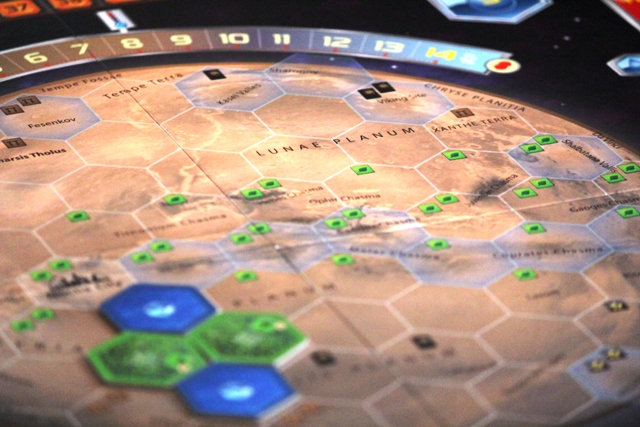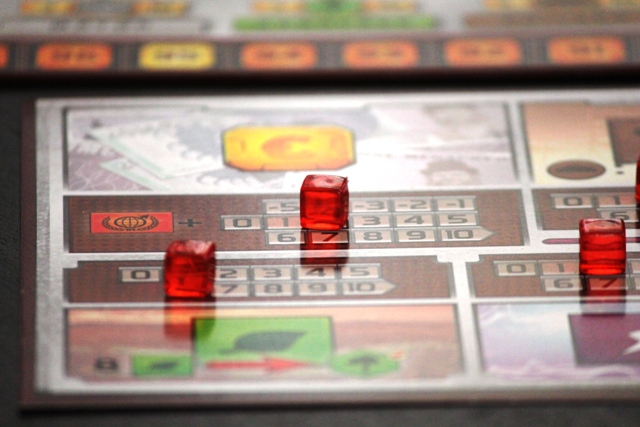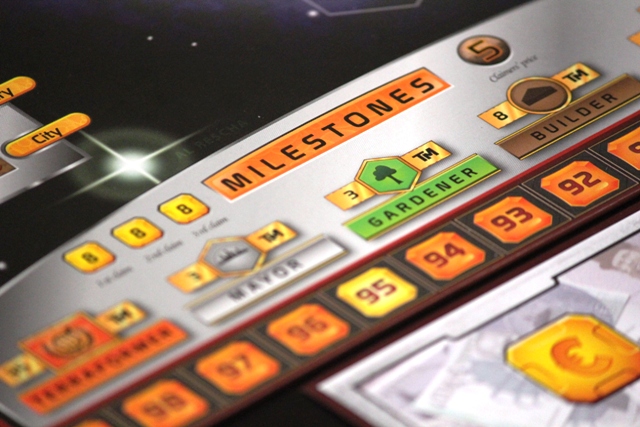Terraforming Mars – A Review

What is it? Drive your corporation toward the pinnacle of human achievement and the quest to make a new world habitable. But the Red Planet is named after a god of war for good reason, its harsh climate and barren terrain will make every decision one of great consequence.
208 unique cards. This is the crowning jewel in Terraforming Mars’ ornately adorned appeal. Just think on that for a moment – how many games can you list where every card in the deck is wholly distinct? That’s almost the sum of both Race and Roll for the Galaxy’s cards and tiles. And for a game built upon the way in which these cards interact, I’d imagine that finding the right balance is a process with an uncanny resemblance to Dante’s Sixth Circle of Hell (it’s Heresy, if you were curious).
Because as interesting as the theme may be, and in this instance it is genuinely engaging, if that house of cards hasn’t been built with the proper care, it’ll all come tumbling down. Terraforming Mars has come out of Essen with a decent head of steam and enough accolades that the question of whether it’s a decent game or not is pretty much settled – but is it the game for you?
Is There Life on Mars?
A quick overview: about 400 years in the future. we’ve begun the massive project of making Mars hospitable to human life. Corporations, as they are wont to do, have identified this venture as an extremely profitable one and with the sponsorship of Earth’s World Government are hoping not only to succeed in creating a new habitat for mankind, but taking a first step toward advancing their interests through the solar system. It’s your job as the embodiment of one of these corporations, to execute this plan. At your disposal – a host of incredible technologies and a reserve of resources with which to put them to good use.
The objective? Reach three targets to trigger the final round, at the end of which the most Victory Points indicates the winner. Place all 9 Ocean tiles onto the board, raise the temperature to a balmy 8 degrees Celsius and place enough Greenery tiles to increase the Oxygen levels to 14%. These are communal goals, which means that the game can play as long or as fast as the players are willing to contribute to all three goals.
Most of the action does not actually take place on the main game board, with it’s hexagonal rendering of the surface of Mars. Rather, it’s your player board with its production tracks and resource pools that will capture your interest for the game’s duration. And Martian domination begins with just six resources: MegaCredits, Steel, Titanium, Plants, Energy and Heat. It’s in how you manage these resources and their production that the game is one or lost. And of course, those cards.
There will be a familiarity to anyone who has played Race for the Galaxy before. Not just in the theme and cardplay as engine building, but in the initial struggle of trying to wrap you head around the various icons and terminology. It’s not as bumpy a first ride, but a cursory glance at the rulebook and a video or two on Youtube, at least in my experience, are a touch deceptive in how easy it may appear to get up and running. And unfortunately that rulebook is a weakness, far too vague about important elements and just not particularly well laid out, but that’s likely a personal preference.
Back to the cards. The first twist to an established formula that TM throws up is that cards essentially have a double cost. Whether drawn in the first round or subsequent turns, players need to cough up 3 MegaCredits for each card they choose to add to their hand. When played from hand to table, each card has an additional cost that’s based upon how powerful the effect is, and these costs range from as little as 1MC or 2MC all the way up as much as 35MC or more. You would correctly deduce that the cost is paid using your MegaCredits resource, but here again TM makes things interesting. Certain cards can be paid for using Steel or Titanium in addition to MC, but each Steel resource is worth 2MC and each Titanium resource is worth 3MC. So where it would take 30 resource cubes worth of MC to pay for a card with a 30 cost, you could pay the same with just 15 Steel or 10 Titanium (or any combination of the 3).
From melting ice caps to underground detonations to introducing worms to the terrain, those cards are the gooey, treacley goodness at the center of TM. Some increase production rates, some provide a shortcut to placing tiles on the board and some simply provide victory points. Some will allow additional actions or screw other players over. Most also have tags, such as a Science tag or an Earth tag that act sometimes as requirements and at others may provide additional bonuses.
Turns are fairly fluid affairs, choose to do one or two actions, repeatedly cycling through players until everyone has passed. More often than not this will mean playing cards, but you can also pay 8 plant resources to place a Greenery tile or 8 heat resources to raise the temperature. There are also Standard Projects as well as Milestones and Awards, but I’ll touch on those later.
Just to touch on the board and the other tiles available. In addition to Greenery tiles and Ocean tiles, there are City tiles and a few that relate to specific cards. There are certain rules around placement, but the gist of this is that placing tiles can provide small resource bonuses such as two extra plants or some extra steel, Greenery tiles are worth points and cities are worth points for each Greenery tile adjacent. Tiles can also increase your Terraforming Rank, which is both the foundation of your end-game final tally, as well as the initial value for the amount of MegaCredits you produce in each rounds Production phase (which is then added to the value on your MegaCredits track).
Players also have the option of selecting asymmetric Corporations if the matching beginner Corporations feel too vanilla, and these provide variable starting conditions as well as subtly informing your strategy. Mixing things even further are the Milestones and Awards, the former being a VP bonus that can be claimed by the first person to reach a particular milestone, while the latter is more a case of betting on fulfilling an end-game condition, such as having the most Heat resources. And with scoring generally a close affair, the 5 VPs these offer can be the difference between winning and losing.
Mars Attacks
I mentioned the art of balance earlier, and designer Jacob Fryxelius has done a masterful job in getting about as close to finding the right balance is I’d imagine it’s possible to get. For a game of this type, card draw is generally the hill you live and die on. And when the variety is as high and the play time as long as it is in Terraforming Mars, the stakes are even higher. If it were left to the cards alone, luck would have far too great a say. Draw cards that increase your MegaCredit production early for instance, and you’re already a step or two above your opponents. And I’ve seen this happen in every game of TM I’ve played thus far – someone always lucks out and seems to be streets ahead of everyone else by the third round.
But Jacob shows his true genius with the incorporation of three important mitigating factors. There’s the cost to put a card in hand as I’ve already mentioned, which means that no matter how fantastic the card is there’s always a sacrifice to playing it. Secondly, is the implementation of requirements. Certain cards require the temperature or oxygen levels to have reached a certain point, or that you have a set number of Earth tags in your existing tableau, stipulations that only occur very late in the game. And whilst you don’t have a hand limit, holding on to cards that will only pay off is a risk. Lastly, there are the Standard Projects. These are essentially expensive shortcuts, avenues for placing greenery tiles or increasing the temperature level of adding cities to the board by paying MegaCredits. Yes, they can be expensive – putting a Greenery tile down costs 23MC – but in a pinch they can keep you in the game if card draw has a grudge against you.
And if this isn’t enough luck mitigation for your tastes, there’s a draft variant. We haven’t played it as yet, but the feedback has been largely positive. My only personal hesitation is that choosing which of the 4 cards you draw each round is already a process prone to AP, I can imagine the game playing even longer if you’re throwing drafting into the mix every round. For those who enjoy a high degree of player interaction, TM is for the most part a solitary experience. There is a take-that element in that certain cards allow you to reduce an opponents resource production to increase yours, or steal the occasional resource, but it happens far too infrequently over a two hour span so as to cause genuine conflict.

Some of the better card art. Top left is the card cost, and the requirement is an existing 5 Science tags in your tableau
A word on components. The artwork is erratic at best – the board itself is serviceable but the art on the cards veers wildly from fantastic images of massive cosmic impacts to odd amalgams of stock photos and basic colour filters. Resources are handled by cubes of varying sizes, the colour palette of which I found somewhat odd, using gold and silver and bronze, and since these are used to indicate credits and plants and steel and titanium it’s very easy to confuse them on your player boards. And woe unto they who bump the table, the resource track markers seem hellbent on shifting at the smallest of prompts. Yes, not every game has the luxury of implementing Scythe’s duel-layered player mats and it’s a tricky problem to overcome on a limited budget, but it remains an issue.
Here’s the thing though – it doesn’t matter a whit. You’re always far too engaged in wrapping your head around a card’s ability or how it plays into your long-term strategy that you barely notice the artwork. Yes those resources cubes aren’t ideal and keeping track of everything is a tad clunky but I don’t care because if I can just get this Domed Crater out on the next turn…
Of greater concern is the game’s reliance on all the players being invested in prodding it like an unwieldy space cow toward the finish line. Because those end-game triggers are completely within the players’ collective control, things can devolve into a game of space chicken where everyone waits for everyone else to make the first move. You want that Oxygen track to hit 4% so you can play Worms, but you don’t want to be the one to have to get it there. It’s not overly prevalent and it’ll likely become less of an issue over multiple plays, but it is exacerbated by my other main criticism which is the closing third. At a certain point, pushing your production track beyond a certain level becomes counter productive. Producing heat when the temperature gauge has maxed out is inefficient, so any cards you draw in the closing rounds that increase heat production are rendered useless. And the same goes for certain other card effects.
I’d expect the final rounds of a game to be the most critical, the most punishing on mistakes and the most demanding on decisions, but with TM it feels more as if those critical moments occur mid-game, whilst the final moments play out on auto-pilot with a last dash for Milestones, Awards and terrain. In fairness though, this does feel almost like scolding an eager space puppy – all TM wants to do is make you happy and in its enthusiasm it sometimes knocks a vase off the coffee table.
And the more I think about it, the more that seems like an appropriate analogy. The game is far from perfect, what with its unwieldy length and inconsistent component quality, but it’s just so damn fun to have around the house. Never boring, with a wealth of replayability and interesting decision-making, it’s not hard to see why Stronghold Games backed the Fryxelius’ creation as proudly as they did. The best thing I can say about Terraforming Mars is that it makes me want to be a better player. And I can’t think of higher praise.
Review copy kindly provided by Solarpop Distribution.
Pros:
- Multiple tweaks to mitigate luck
- Card variety
- Excellent theming
- Variable player powers
- High replay value
- Solo variant
Cons:
- Component quality
- Length
- Player mats
Terraforming Mars plays a bit too long for what it is. It's also somewhat precariously placed - anything from an errant elbow to a run of bad card draws could make the experience as pleasant as a Martian dust storm. And yet I love it. From the attention to detail and the obvious passion the developers have for the theme, to the always entertaining card-play and simple thrill I get from managing multiple tracks, Stronghold have themselves another winner.









